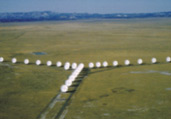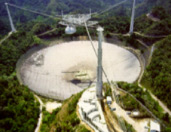Lessons Overview : Radio Astronomy and Its Tools
In 1931, it was accidentally discovered that radio waves were emitted naturally by a source in the sky. With this discovery, radio astronomy was born, and other types of astronomy soon followed.Radio astronomers also use telescopes. Radio telescopes take two forms: a lone antenna, or an antenna mounted on a dish. Stand-alone antennas are pieces of pipe and wire of specific dimensions designed to pick up a certain frequency of radio wave. These telescopes are much easier and less expensive to construct than radio dishes. Radio dishes look very similar to satellite dishes you may have seen mounted on people's homes. They use their large surface area to collect more radio waves and reflect them to the antenna, mounted above the rounded dish.
Radio dishes range from a few meters to hundreds of meters in diameter. You may have heard of some of these larger dishes, like those at the National Radio Astronomy Observatory in Green Bank, West Virginia, or the Arecibo Observatory in Puerto Rico.
There are, however, physical and financial limitations to the size of a single dish. Astronomers have worked around this problem by using combinations of dishes arranged in specific patterns to emulate a single large dish. This technique is called interferometry.
One example of an interferometer is the Very Large Array (VLA) in New Mexico, whose 27 individual dishes mounted on a Y-shaped track can be moved to form the equivalent of one dish up to 36 kilometers in diameter. The Very Long Baseline Array (VLBA), which consists of a series of ten large radio dishes spread across the planet from Hawaii to the Virgin Islands, has an effective diameter of over 8,000 kilometers . That's approximately two-thirds of the diameter of the Earth!
Very Long Baseline Array (VLBA)

Courtesy of National Radio Astronomy Observatory / Associated Universities, Inc. / National Science Foundation
Very Large Array (VLA)

Courtesy of National Radio Astronomy Observatory / Associated Universities, Inc. / National Science Foundation

Courtesy of National Radio Astronomy Observatory / Associated Universities, Inc. / National Science Foundation
Very Large Array (VLA)

Courtesy of National Radio Astronomy Observatory / Associated Universities, Inc. / National Science Foundation
Arecibo Radio Observatory

NAIC - Arecibo Observatory, a facility of the NSF

NAIC - Arecibo Observatory, a facility of the NSF